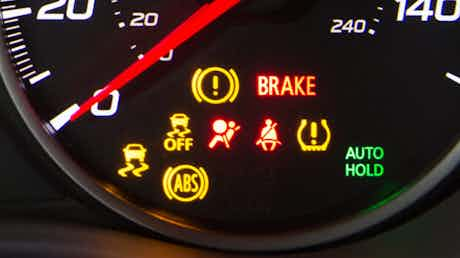What is limp mode? Symptoms, causes, and how to fix it
August 29, 2024 by David Motton

If you experience a loss of power and see some warning lights on your dashboard, then it may be that your car is in limp mode.
It’s called this because the car will limit power to protect it from possible damage, while still allowing it to hobble on to your garage or destination.
There are several reasons why a car may go into limp mode, and in this guide we’ll look at the symptoms, causes and potential remedies. We’ll also explain how to bypass limp mode, and whether this is ever a good idea.
What is limp mode?
Think of limp mode as your car’s way of protecting itself. If it develops a fault (typically with the engine or transmission) then the car may restrict revs and power. The idea is the car is still driveable, but only slowly to prevent the fault causing serious damage.
Aside from the sudden loss of power and warning lights, your car may also exhibit a few other symptoms when going into limp mode:
- Auxiliary functions may stop working, such as heating and air conditioning
- The maximum revs will be limited to as low as 2,000-3,000rpm
- In an automatic you may be locked into a low gear
- Maximum speed will be restricted to 30-50mph

Limp mode causes
Limp mode is activated when the ECU (electronic control unit) notices that something is not operating within predefined parameters, this can be caused by a variety of factors such as:
- Extremely low levels of oil or coolant
- Transmission errors – such as when the gearbox can’t change gears properly
- Brake malfunctions – seized brakes or a hydraulic leak in the system
- Wiring issues – a problem with the wiring loom may cause erratic behaviour
- Engine issues – issues such as misfiring or turbo problems
How to get your car out of limp mode
The reasons for your car entering limp mode are varied but can be serious, so it’s best to have it examined by a mechanic as soon as possible. The mechanic can take the car out of limp mode when they fix the fault.
You should never ignore the warning signs, but how soon you can attend to the issue depends on how far you are from a safe stopping point and how the car is driving.
If possible, check the oil and coolant levels as well as any obvious signs of wiring damage or leaking fluids under the car.
You may be able to reset the car by switching it off and on again after about 30 seconds. If the warning lights disappear and the car behaves normally, then it may have just been a temporary glitch. Pre-system checks may see limp mode activate as soon as the car is turned back on though, or the issue could present itself again after you have been driving for a while.
If it goes straight back into limp mode, then it is best to book the car in for a thorough check by a professional. You can either drive it to your garage if the issue is not severe, or have the car rescued. The cost to have the error repaired will vary from a simple labour charge for an ECU reset, to many thousands of pounds if the problem is serious and lies with the engine or gearbox.

How to bypass limp mode
You can attempt to bypass limp mode by restarting the vehicle after a short wait. Alternatively, you could try removing one of the battery terminals to reset the electronic systems.
You can also check the fluid levels to see if that is the cause of the problem or have the error reset electronically to see whether it was a temporary glitch.
Just remember, it’s not a good idea to ignore whatever problem has caused the car to enter limp mode. If restarting the car, resetting the electrics, or topping up fluids doesn’t fix the problem, the car will need to be looked at by a mechanic.

Limp mode FAQs
Can I drive my car in limp mode?
The whole point of limp mode is that the car is driveable, albeit with reduced performance. If it or feels like something is seriously wrong, then it’s best to have it recovered to a mechanic.
Driving in limp mode for an extended period can worsen whatever may be wrong with the car. It’s also worth highlighting that if your destination is some way off or requires joining fast roads (which could be dangerous with reduced performance), you may want to have it rescued.
How fast can I drive in limp mode?
This depends on what parameters the manufacturer has set, in most cases you will be limited to no more than 30mph to 50mph and will not be able to rev the car above 3,000rpm or change into higher gears if it is an automatic.
Which sensors can cause limp mode?
Limp mode can be caused by sensors in the oil and coolant system, transmission or engine sensors, wiring issues, or if sensors find a problem with the brakes or hydraulics.
How can I disable limp mode permanently?
Even if you can find a way to permanently disable limp mode, it’s not a good idea. Limp mode exists to prevent a fault from becoming worse, potentially causing thousands of pounds of damage. If limp mode prevents a catastrophic failure at speed, it could even avoid a serious collision.
The best way to get your car out of limp mode is to have the underlying fault fixed.
Cars Change? Carwow!
Looking for a new set of wheels? With Carwow you can sell your car quickly and for a fair price – as well as find great offers on your next one. Whether you’re looking to buy a car brand new, are after something used or you want to explore car leasing options, Carwow is your one stop shop for new car deals.















